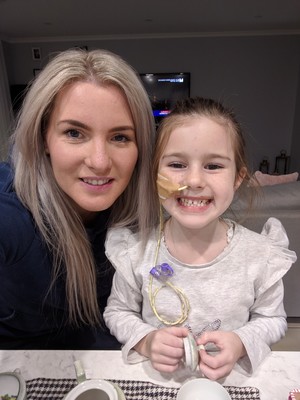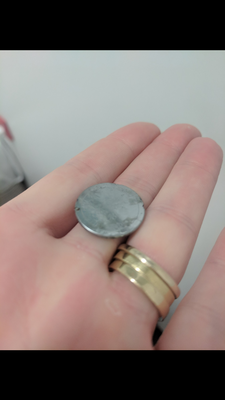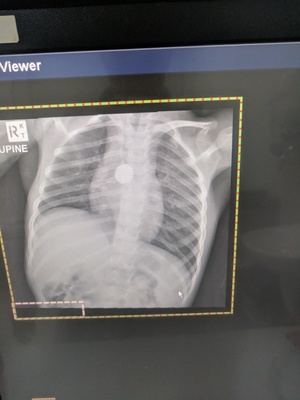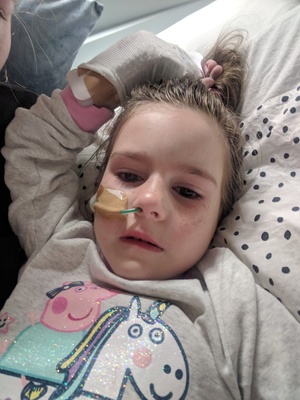By Melissa Grant
Six-year-old Shaylah Carmichael is lucky to be alive.
For months, a deadly button battery was stuck inside the little girl’s oesophagus.
Mum Kirra long suspected something was seriously wrong – her usually happy daughter was vomiting, refusing to eat and complaining of a sore chest and throat.
Never could she have imagined the source of pain was a button battery, a coin-sized device that can burn through the oesophagus within hours, leading to serious injury or death.
Although desperate for answers, Kirra says a number of medical appointments failed to shed any light on the dire situation.
When Shaylah was unable to keep liquids down on March 31 this year, she presented to Casey Hospital’s emergency department.
Kirra said she was initially told to take Shaylah home but refused. The mother of three said a barium swallow test was eventually ordered by a pediatrician, who was concerned by a home video showing the little girl drinking and making strange gurgling sounds.
That test was preceded by an X-ray, which revealed Shaylah had swallowed a button battery. She was then rushed to the Monash Children’s Centre for emergency surgery.
“We didn’t know whether she was going to survive,” Kirra recalled.
“They said ‘let’s just make it through the first 12 hours, then 24 hours, then 48 hours’.”
Kirra said Shaylah, affectionately known as Dolly, was placed in an induced coma for three days and fed through a nasogastric tube for two months.
“Dolly had to be fed through the tube because her oesophagus was so badly eroded from the batteries,” she said.
Kirra estimates the button battery was stuck inside Shaylah for six months.
The prep student is now undergoing regular surgeries to dilate her oesophagus and her long-term prognosis is unclear.
“The doctors said ‘we haven’t seen a case like this before. We will have to take it day by day’,” Kirra said.
She believes her youngest child is incredibly lucky to have survived.
“Dolly’s button battery wasn’t fully charged. They said she is so lucky. They said (at the time) another 24 hours and she wouldn’t be here,” she said.
In a statement, Monash Health said it had apologised to the Carmichael family.
“Monash Health has been in touch with the family to discuss the treatment and care provided and apologised for any distress caused by their experience at Casey Hospital,” the statement said.
“Button batteries are small and can cause serious injuries in children. They are often found in toys and other devices that children like to chew, which makes them all the more dangerous and often require surgery to remove.”
Kirra is now on a mission to have mandatory safety standards introduced for button batteries.
“Look at how many kids have died from this,” she said.
“They (devices with button batteries) are just sitting there on racks ready for any kid to pick up.”
Kirra said it wasn’t until after the ordeal that Shaylah revealed the button battery had come from the remote used for the family’s television soundbar.
“She said ‘I was just playing with it and accidentally swallowed it’.
“I said ‘why didn’t you tell dad?’
“She said, ‘I went to the toilet, coughed and it went away’.”
In August, Kirra met with Kidsafe Victoria to discuss raising greater awareness about the dangers of button batteries.
Kidsafe estimates 20 children each week present to Australian emergency departments with a button battery related injury – that’s more than 1000 kids every year.
“If ingested, a button battery can become stuck in a child’s throat where saliva immediately triggers an electrical current which causes a chemical reaction that can burn the oesophagus in as little as two hours, causing severe life-threatening injuries and in some cases death,” Kidsafe Victoria General Manager Jason Chambers said.
Kidsafe Victoria supports calls for tougher safety regulations and a mandatory safety standard for products containing button batteries.
The Australian Consumer and Commission (ACCC) has called for the government to introduce new safety standards, including a requirement for all button batteries to be secured inside products.
Kirra’s message to parents is to dispose of anything that may be powered by a button battery.
“It’s just not worth the risk,” she said.
BUTTON BATTERIES – WHAT YOU NEED TO KNOW:
- Button batteries can burn through the oesophagus in hours, causing internal burns, severe bleeding or death.
- Common items button batteries are found in include: Remotes, watches, thermometers, calculators, torch keyrings, hearing aids, kitchen scales, musical greeting cards, fake candles
- Items with button batteries should have a secure battery compartment and placed out of the reach of children
- A child who has swallowed a button battery may develop chest pain, coughing, nausea/vomiting, difficulty swallowing and fever
- If you think a child has swallowed a button battery immediately phone the Poisons Information Centre on 13 11 26.
(Source: Kidsafe Victoria)











